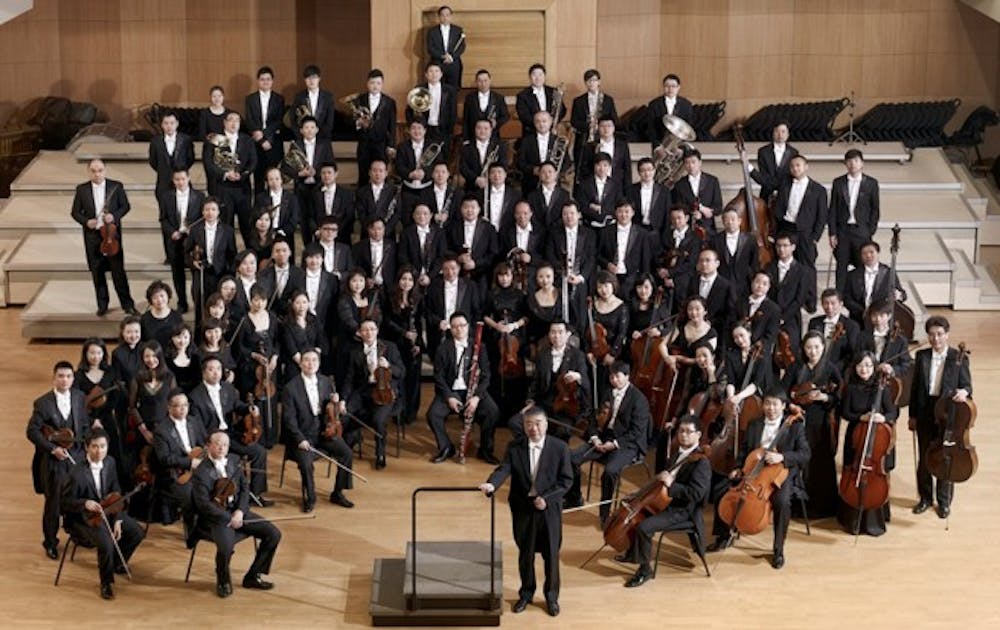Once used toward political and revolutionary ends, Western classical music in China has been redefined on its own terms.
This Thursday, the internationally recognized China Symphony National Orchestra will play in Page Auditorium. Their performance illustrates the growing coalescence of traditional Chinese and Western classical influences. “You can hear a sort of Chinese melody in the music played, but the harmony and format is Western,” said Hsiao-Mei Ku, Professor of the Practice of Music and member of the Ciompi Quartet.
The first half of the performance presents Chinese composers Chen Gang and He Zhanhao’s Butterfly Lovers’ Violin Concerto, featuring soloist Chuanyun Li, and Xia Guan’s Earth Requiem, a somber response to the earthquake in Sichuan Province. During the second half, the Orchestra will play Beethoven’s Symphony No. 7 in A Major.
“Duke Performances has presented very little Chinese art or East Asian art in particular,” said Aaron Greenwald, Director of Duke Performances. “So this was an ideal opportunity to bring something that was simultaneously Eastern and Western.”
Greenwald also discussed the importance of pursuing a constant growth of cultural exchange between Duke’s campus in Durham and its campus in Kunshan.
“I think a lot of us at the institution are trying to figure out how we can make Duke a place where there is a greater engagement with Chinese culture and with the Kunshan campus,” Greenwald said. “This was a fairly straightforward way to make that kind of transaction and to see what the response was.”
In order to teach audience members about the history and relationship between China and Western classical music, Ku hosted a lecture last night featuring Professor Jindong Cai, Music Director and Conductor of Stanford Symphony Orchestra, and his wife Sheila Melvin, both scholars on Western music in China.
“In general, classical music in China was always accompanied with a different purpose [than Western classical music],” Cai said.
When missionaries initially exposed China to Western styles of music more than 400 years ago, classical music was used to pique the interest of Chinese leaders. Sharing unfamiliar instruments and technology with the Chinese allowed missionaries to more easily evangelize and build missionary schools.
After the Opium War, Western classical music became a source of entertainment for foreigners in big cities like Shanghai. While one of the earliest symphonies was created in Shanghai in 1879, not a single symphony or audience member was Chinese until 1927.
When the doors opened for wider populous to enjoy and even study classical music, some Chinese young adults believed that classical music could potentially heal existing social and cultural problems in China. They viewed Western classical music as progressive and elite and Chinese music as traditional and backwards.
“Young artists were comparing China to what they saw in countries like Germany and believed that if the Chinese people went to concerts every week, they would become more civilized,” Cai said.
It was only after the Japanese invasion in the early 1930s that Western classical music finally became more political. Young students began to see the narrow role classical music could play to reform Chinese social and cultural problems.
Nie Er, a young composer also struggling to consider the role of music during the invasion, visited seaports and night clubs to better understand the struggles of working class Chinese. Er eventually wrote what became the national anthem of the People’s Republic of China, “March of Volunteers,” which solidified the use of music as a political force.
“Music can inspire people,” Cai said. “The rule at that time was that art had to serve a political purpose, to unite the masses to go against the Japanese.”
While art is often celebrated for its own sake—without added requirements of political or social discourse—Chinese composers still feel the urge to create music that represents a wider public. Personal reflections—e.g. musings about the beauty of a flower—are not considered sufficient inspiration for larger symphonic works. This can be seen even in pieces such as Xia’s Earth Requiem, which reveals more about the tragedy in Sichuan than his own artistic aspirations and questions.
Despite these differences, Western-influenced classical music has continued to grow in appeal in China, and millions of Chinese youths learn to play the piano or string instruments.
“People ask me if I think the future of classical music is in China,” Cai said. “It depends on how you define classical music. If you think the Chinese can use the orchestra symphony format to create something different, something closer to their culture, then I do believe that China can go forward with it.”
The China National Symphony Orchestra will perform in Page Auditorium tonight at 8 p.m. Duke student tickets are $10.
Get The Chronicle straight to your inbox
Signup for our weekly newsletter. Cancel at any time.

